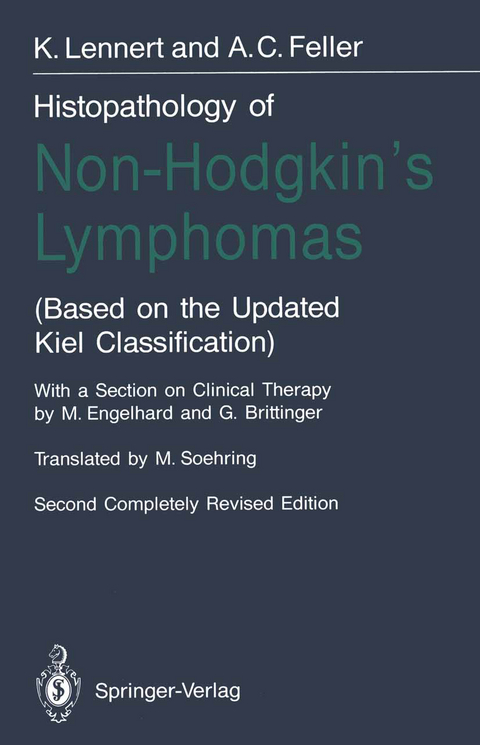
Histopathology of Non-Hodgkin’s Lymphomas
Springer Berlin (Verlag)
978-3-642-97189-1 (ISBN)
The 1st Edition of Histopathology of Non-Hodgkin's Lymphomas, written in col laboration with Professor H. STEIN and published in 1981, was received well and is now out of print. In the meantime, there has been an explosion of data that not only have made the definitions of various entities more precise but, above all, have confirmed the main entities originally delineated in the Kiel classification. The development of monoclonal antibodies and molecular cytogenetics has also made it possible to identify T-cell lymphomas more accurately. For example, many of the malignant lymphomas that were previously considered to be unclas sifiable can now be included in a classification scheme that places the T-cell lymphomas alongside of the list of B-cell lymphomas. In 1988 the European Lymphoma Club published an "updated Kiel classification" (STANSFELD et al. 1988) based on this new knowledge. It includes a number of previously undefined types of T-cell lymphoma. Studies done in Japan (T. SUCH! et al.) and China (L. Y Tu) have contributed to the understanding of these lymphoma types.
1 The Diagnosis of Lymphoma.- 1.1 Practical Tips.- 1.2 Immunohistochemistry and Molecular Genetics as Ancillary Diagnostic Measures.- 2 The Kiel Classification.- 2.1 Principles.- 2.2 Pros and Cons.- 2.3 Comparison with Other Lymphoma Classifications, Including the Working Formulation.- 2.4 Cytological Basis.- 2.5 Statistical Data.- 2.6 Therapeutic Principles by M. Engelhard and G. Brittinger.- 3 B-Cell Lymphomas.- 3.1 Low-Grade Malignant Lymphomas of B-Cell Type.- 3.2 High-Grade Malignant Lymphomas of B-Cell Type.- 3.3 Rare and Ambiguous Types of B-Cell Lymphoma.- 4 T-Cell Lymphomas.- 4.1 Low-Grade Malignant Lymphomas of T-Cell Type.- 4.2 High-Grade Malignant Lymphomas of T-Cell Type.- 4.3 Rare and Ambiguous Types of T-Cell Lymphoma.- Addendum: Methods for the Diagnosis of Lymphoma.- References.
From the reviews:
"Dr. Alfred Feller and Dr. Jacques Diebold have presented us with succinct descriptions and high quality Giemsa-stained photomicrographs ... . Their most valuable contribution, however, is their discussion of unresolved problems of classification ... . The authors also bring attention to significant unresolved problems in the WHO classification, including thought-provoking discussions of ... . are to be congratulated for a job well done and for a most enjoyable and personal approach to the complex problems of lymphomas." (Maurice P. Barcos, Oncology Intl. J. Cancer Research and Treatment, Vol. 67(5-6), 2004)
"Feller and Diebold's book is not only based on the WHO classification of lymphoma, but also mirrors its presentation ... . then follows something really good: a section specifically addressing, and indeed called, differential diagnosis. ... Another good feature of this book is its inclusion of organ-specific sections, for example, lymphoma of the lung ... . I liked this book. It is not simply a catalogue of lymphomatoid diseases. I think it will be practically useful." (Dr. D. Wright, ACP News, 2005)
| Erscheint lt. Verlag | 22.1.2012 |
|---|---|
| Co-Autor | M. Engelhard, G. Brittinger |
| Mitarbeit |
Assistent: M. Paulli, A. Le Tourneau |
| Übersetzer | M. Soehring |
| Zusatzinfo | XIV, 312 p. |
| Verlagsort | Berlin |
| Sprache | englisch |
| Maße | 170 x 242 mm |
| Gewicht | 562 g |
| Themenwelt | Medizin / Pharmazie ► Medizinische Fachgebiete ► Onkologie |
| Studium ► 2. Studienabschnitt (Klinik) ► Pathologie | |
| Schlagworte | Bone marrow • Cell • classification • Differential Diagnosis • Extra-nodal non-Hodgkin lymphomas • Genetics • Histopathology • Kiel classification • Lymphoma • Lymphomas • molecular genetics • Non-Hodgkin lymphomas • Pathology • tissue |
| ISBN-10 | 3-642-97189-X / 364297189X |
| ISBN-13 | 978-3-642-97189-1 / 9783642971891 |
| Zustand | Neuware |
| Informationen gemäß Produktsicherheitsverordnung (GPSR) | |
| Haben Sie eine Frage zum Produkt? |
aus dem Bereich


